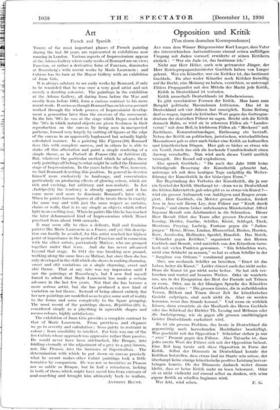French and Spanish
TnnEE of the most important phases of French painting during the last 50 years are represented in exhibitions now running in London. Various aspects of Impressionism appear at the Adams Gallery where early works of Bonnard are on view; Fauvism, or rather a derivative form of Fauvism, dominates at Rosenberg's with recent works by Marie Laurencin ; and Cubism has its turn at the Mayor Gallery with an exhibition . of Juan Gris. , . It is always salutary to see early works by Bonnard, if only . to be reminded that he was once a very good artist and not • merely a dazzling colourist. The paintings in the exhibition at the Adams Gallery, all dating from before the War and _ mostly from before 1905, form a curious contrast to his more recent work. It seems as though Bonnard has on his own account
worked through the whole process of Impressionist develop- ment a generation later than the creators of the movement. In the late '90's he was at the stage which Degas reached in the '70's in which natural objects are given freshness in their reproduction on the canvas by being seen in. unexpected patterns, formed very largely by cutting off figures at the edge of the canvas in an apparently haphazard but actually highly calculated manner. In a painting like Figures (10) Bonnard does this with complete success, and in others he is able to shake off this affectation and paint a simple rendering, of a . simple theme, as in Portrait de Femme (30) or Interieur (2). But, whatever the particular method which he adopts, these early paintings all belong to what might be called the Humanist stage of Impressionism. In the years before the War, however, we find Bonnard deserting this position. In general he devotes himself more exclusively to landscape, and concentrates particularly on producing effects of glowing colour, which are rich and exciting, but arbitrary and non-realistic. In Les Andelys (11) the tendency is already apparent, and it has come more and more to dominate Bonnard's later style. When he paints human figures at all he treats them in exactly the same way and with just the same respect as curtains, chairs or walls, that is to say simply its objects which reflect light in an exciting way. When he paints like this he has reached . the later dehumanised kind of Impressionism which Monet practised from about 1880 onwards.
It may seem silly to class a delicate, frail and feminine painter like Marie Laurencin as a Fauve, and yet this descrip- tion can hardly be avoided, for this artist reached her highest point of importance in the period of Fauvism and in connexion with the other artists, particularly Matisse, who are grouped together under that term. And she has never . advanced beyond that stage. In 1911 she was breaking new ground, working along the same lines as Matisse, but since then she has only developed in the skill which she shows in making charming, sweet and chic variations on a single charming, sweet and chic theme. That at any rate was my impression until I saw the paintings at Rosenberg's, but I now find myself forced to admit that Marie Laurencin has made a certain advance in the last few years. Not that she has become a more serious artist, but she has produced a new kind of variation on her theme. Instead of being almost entirely flat her new paintings are modelled so as to give some sort of reality to the forms and sonic complexity to the figure grouping. The most recent of the paintings shown, Repetition (21) is, considered simply as a plaything in agreeable shapes and rococo colours, highly satisfactory.
The exhibition of Juan Gris provides a complete contrast to that of Marie Laurencin. From prettiness and elegance we go to severity and calculation ; from gaiety to restraint in colour ; from sensibility to intellect. For Gris was one of the few Cubists whose approach was aggressive rather than passive. He would never have been sidetracked,' like Braque, into 'fiddling eternally at the adjustment of a grey to a grey-brown, -nor, like Picasso, into the fantasies of Superrealism. The -determination with which he put down On canvas precisely what he meant makes other Cubist paintings look a little tentative by comparison. He was not so inventive as Picasso nor so subtle as Braque, but he had a robustness, lacking in both of them, which might havè saved him from eXCesses of soul-searching and brought him. ultimately back to realiim.
ANTIIONY BLUNT.
















































 Previous page
Previous page